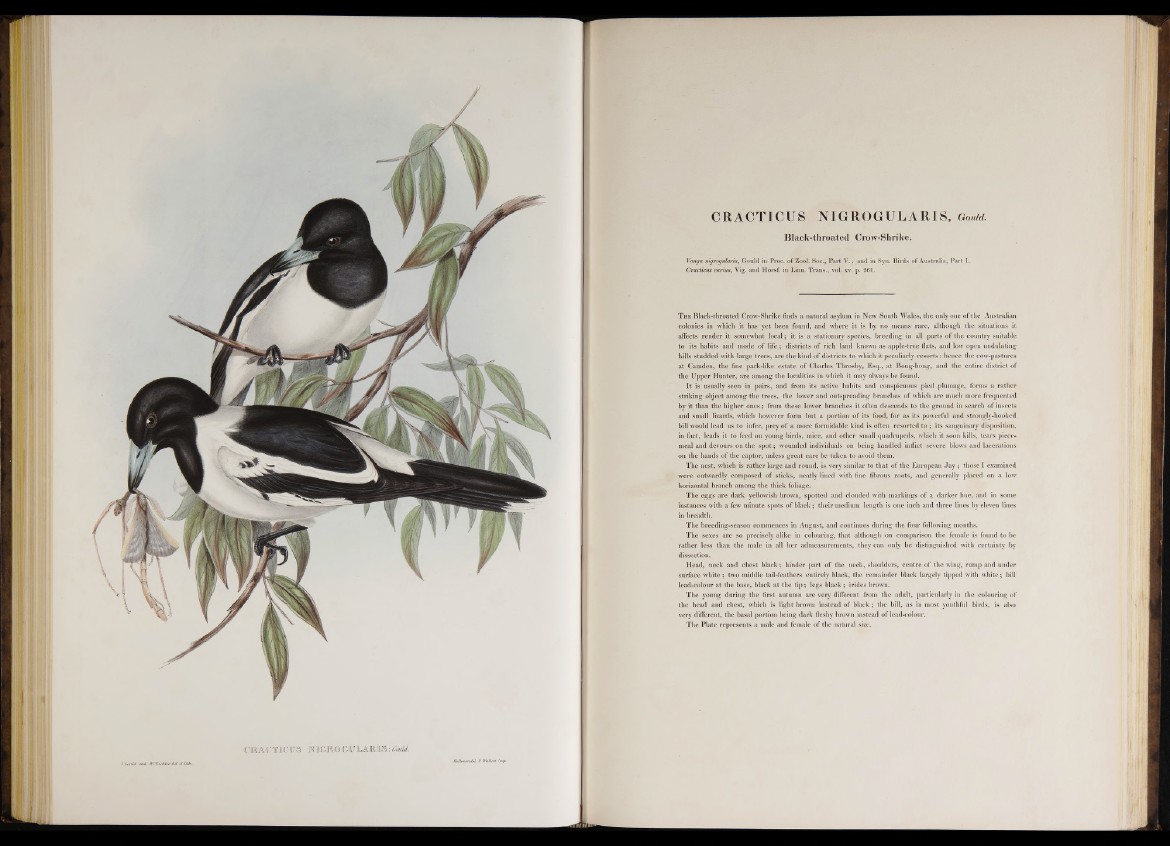
CRACTICUS NIGROGULARI S, Gould.
Black-throated Crow-Shrike.
Vang a nigrogularis, Gould in Proc. of Zool. Soc., Part V .; and in Syn. Birds of Australia, Part I.
Cracticus varitis, Vig. and Horsf. in Linn. Trans., vol. xv. p. 261.
T h e Black-throated Crow-Shrike finds a natural asylum in New South Wales, the only one o f the Australian
colonies in which it has yet been found, and where it is by no means rare, although the situations it
affects render it somewhat local; it is a stationary species, breeding in all parts of the country suitable
to its habits and mode o f life ; districts of rich land known as apple-tree flats, and low open undulating
hills studded with large trees, are the kind o f districts to which it peculiarly resorts: hence the cow-pastures
at Camden, the fine park-like estate of Charles Throsby, Esq., at Bong-bong, and the entire district of
the Upper Hunter, are among the localities in which it may always be found.
It is usually seen in pairs, and from its active habits and conspicuous pied plumage, forms a rather
striking object among the trees, the lower and outspreading branches o f which are much more frequented
by it than the higher ones; from these lower branches it often descends to the ground in search of insects
and small lizards, which however form but a portion of its food, for as its powerful and strongly-hooked
bill would lead us to infer, prey o f a more formidable kind is often resorted to ; its sanguinary disposition,
in fact, leads it to feed on young birds, mice, and other small quadrupeds, which it soon kills, tears piecemeal
and devours on the spo t; wounded individuals on being handled inflict severe blows and lacerations
on the hands o f the captor, unless great care be taken to avoid them.
The nest, which is rather large and round, is very similar to that of the European Jay ; those I examined
were outwardly composed o f sticks, neatly lined with fine fibrous roots, and generally placed on a low
horizontal branch among the thick foliage.
The eggs are dark yellowish brown, spotted and clouded with markings of a darker hue, and in some
instances with a few minute spots o f black; their medium length is one inch and three lines by eleven lines
in breadth.
The breeding-season commences in August, and continues during the four following months.
The sexes are so precisely alike in colouring, that although on comparison the female is found to be
rather less than the male in all her admeasurements, they can only be distinguished with certainty by
dissection.
Head, neck and chest black; hinder part o f the neck, shoulders, centre of the wing, rump and under
surface white ; two middle tail-feathers entirely black, the remainder black largely tipped with white; bill
lead-colour at the base, black at the tip ; legs black ; irides brown.
The young during the first autumn are very different from the adult, particularly in the colouring of
the head and chest, which is light brown instead o f black; the bill, as in most youthful birds, is also
very different, the basal portion being dark fleshy brown instead of lead-colour.
The Plate represents a male and female of the natural size.